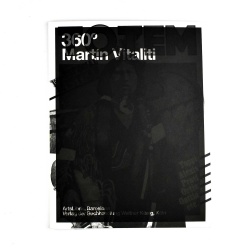Difference between revisions of "360º"
| Line 14: | Line 14: | ||
|ebook = [[Media:Vitaliti Martin 360 2016.pdf|PDF]] (36 mb) | |ebook = [[Media:Vitaliti Martin 360 2016.pdf|PDF]] (36 mb) | ||
}} | }} | ||
| − | "One could call the artist’s book ''360º'' by Martín Vitaliti (Buenos Aires, 1978, lives in Barcelona) a concept-comic. It is based on a single page from ''La Banda del Missouri'' [The Missouri Gang] designed by the acknowledged Italian Hugo Pratt (published in ''TOTEM EXTRA 20. Especial Western'', Editorial Nueva Frontera, Madrid, 1978, p. 91). Its grid of thirteen panels has been reproduced forty-one times while the respective illustrations have been “expanded” by Vitaliti. This results in thirteen panoramic views of each scene throughout the book. The narrative as such — Indians and rangers discovering a riderless horse and a dead body floating in the Missouri river — hasn’t an important meaning. What becomes meaningful is the void of the vast landscape that is developed by Vitaliti’s intervention. He evokes a strange kind of “something in between”, on one hand a visual cinematic effect; on the other hand a frozen storyboard. Compared with other famous panoramic representations of landscapes — think for instance of the ''Panorama of San Francisco from California Street Hill'' (1877) by [[Eadweard Muybridge]], or ''Every Building on the Sunset Strip'' (1966) by [[Ed Ruscha]] — Vitaliti’s approach appears highly complex. What might look as a popular comic book, turned into a Cadavre Exquis, an existing story narrated anew by someone else, that doesn’t develop to a climax but instead remains on hold." (from | + | "One could call the artist’s book ''360º'' by Martín Vitaliti (Buenos Aires, 1978, lives in Barcelona) a concept-comic. It is based on a single page from ''La Banda del Missouri'' [The Missouri Gang] designed by the acknowledged Italian Hugo Pratt (published in ''TOTEM EXTRA 20. Especial Western'', Editorial Nueva Frontera, Madrid, 1978, p. 91). Its grid of thirteen panels has been reproduced forty-one times while the respective illustrations have been “expanded” by Vitaliti. This results in thirteen panoramic views of each scene throughout the book. The narrative as such — Indians and rangers discovering a riderless horse and a dead body floating in the Missouri river — hasn’t an important meaning. What becomes meaningful is the void of the vast landscape that is developed by Vitaliti’s intervention. He evokes a strange kind of “something in between”, on one hand a visual cinematic effect; on the other hand a frozen storyboard. Compared with other famous panoramic representations of landscapes — think for instance of the ''Panorama of San Francisco from California Street Hill'' (1877) by [[Eadweard Muybridge]], or ''Every Building on the Sunset Strip'' (1966) by [[Ed Ruscha]] — Vitaliti’s approach appears highly complex. What might look as a popular comic book, turned into a Cadavre Exquis, an existing story narrated anew by someone else, that doesn’t develop to a climax but instead remains on hold." (from the editor's note) |
</onlyinclude> | </onlyinclude> | ||
[[Category:Artists' publishing]] [[Category:Conceptual comics]] [[Category:Publication]] | [[Category:Artists' publishing]] [[Category:Conceptual comics]] [[Category:Publication]] | ||
Revision as of 08:31, 10 October 2020
 | |
| Author | Martín Vitaliti |
|---|---|
| Language | Spanish (Editor's Note also Catalan/English) |
| Publisher | ArtsLibris (20€) |
| City | Barcelona |
| Date | 2016 |
| Pages | 40 |
| Format | 27 x 21 cm |
| Fabrication | Offset, paperback |
| ISBN | 978-3-86335-943-0 |
| E-book | PDF (36 mb) |
"One could call the artist’s book 360º by Martín Vitaliti (Buenos Aires, 1978, lives in Barcelona) a concept-comic. It is based on a single page from La Banda del Missouri [The Missouri Gang] designed by the acknowledged Italian Hugo Pratt (published in TOTEM EXTRA 20. Especial Western, Editorial Nueva Frontera, Madrid, 1978, p. 91). Its grid of thirteen panels has been reproduced forty-one times while the respective illustrations have been “expanded” by Vitaliti. This results in thirteen panoramic views of each scene throughout the book. The narrative as such — Indians and rangers discovering a riderless horse and a dead body floating in the Missouri river — hasn’t an important meaning. What becomes meaningful is the void of the vast landscape that is developed by Vitaliti’s intervention. He evokes a strange kind of “something in between”, on one hand a visual cinematic effect; on the other hand a frozen storyboard. Compared with other famous panoramic representations of landscapes — think for instance of the Panorama of San Francisco from California Street Hill (1877) by Eadweard Muybridge, or Every Building on the Sunset Strip (1966) by Ed Ruscha — Vitaliti’s approach appears highly complex. What might look as a popular comic book, turned into a Cadavre Exquis, an existing story narrated anew by someone else, that doesn’t develop to a climax but instead remains on hold." (from the editor's note)